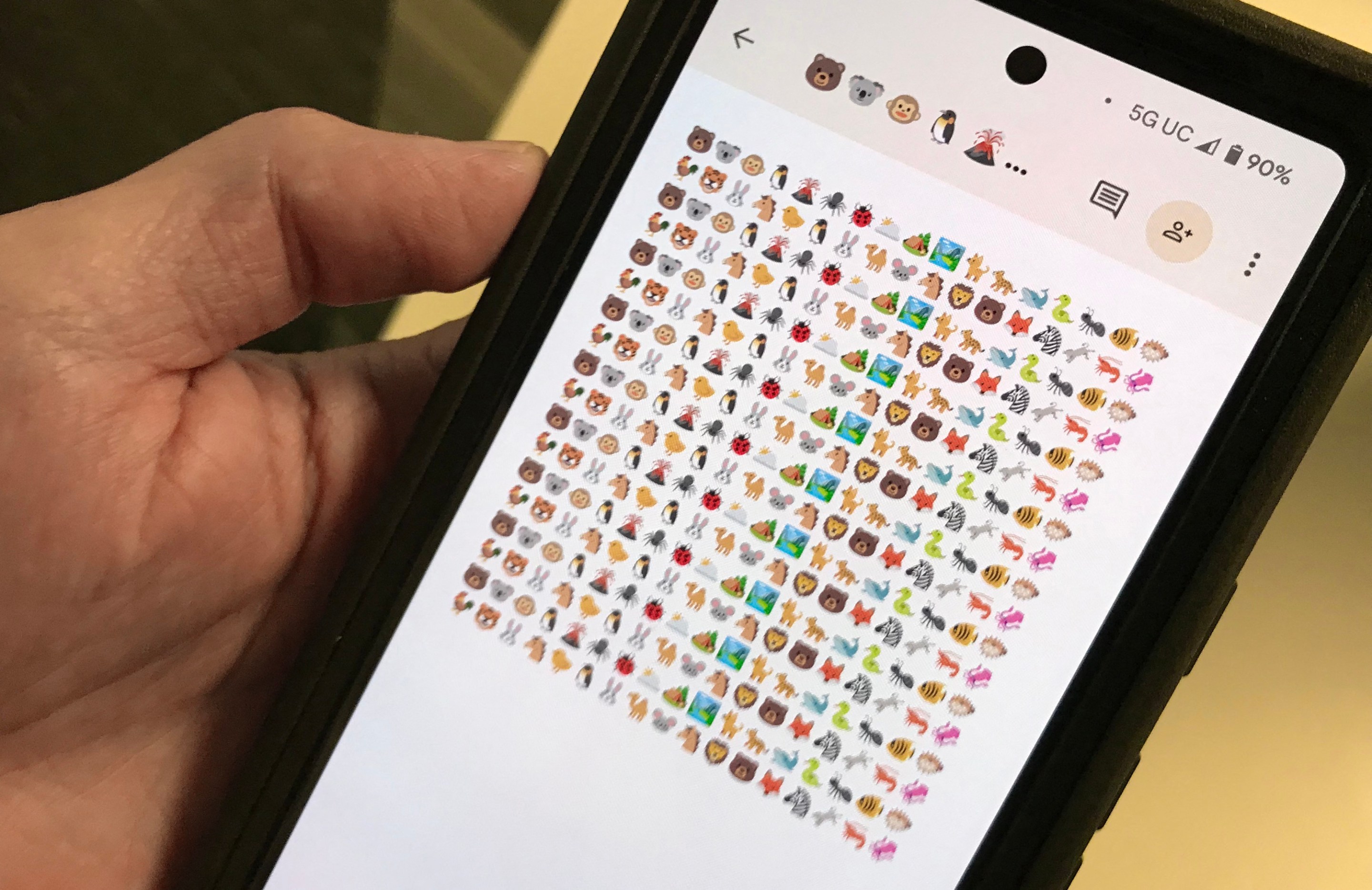When my friend texted me to say that the creature they had recently pulled in one snaking, intact strand from their oblivious chihuahua's anus was a tapeworm, I wished to express my excitement for the dog and grief for the tapeworm the way any of us would: by flooding their screen with tapeworm emojis. But when I typed in "worm" in my emoji search bar, I was presented with two options, only one of which was a worm. (The other was a green caterpillar, which I suppose is worm-shaped?) And the pink segmented swirl of an earthworm bears little resemblance to the limp white angel-hair strand of a tapeworm. And a chihuahua rectum, no matter how small and charming, is no place for an earthworm! Maybe, I thought, sending an emoji of a tape dispenser would communicate my enthusiasm. But when I searched "tape" the only emoji that appeared was a videocassette, and VHS worm felt like a stretch too far. Bereft of other options, I texted back my much blander, rote regards: "congratulations to everyone on the tapeworm!!!"
Animals & Nature represent a significant branch of the emoji tree of life, alongside sister taxa Smileys and Flags. But a new paper published today in the journal iScience found that the 150 identifiable organisms represented in the emoji encyclopedia do not accurately represent the breadth of biodiversity in the real world. This is probably not new for anyone who has ever perused the offerings in Animals & Nature, which includes five different kinds of dogs and three bears but only one fungus and nary a mite in sight. As someone who writes about creatures, I am continually disappointed by the lack of options for the smaller and stranger lifeforms on this planet. Without a diminutive cartoon to send in their stead, I must resort to sending friends the photo of an actual tongue-eating louse or pig butt worm when I wish to include these creatures in the conversation.
(I will concede that there is one perfect animal emoji in existence, that happens to be a vertebrate, and that is Seal 🦭, my tubby king—expectant, polite, voluptuous in body, curious in face.)
The paper pointed out how arbitrary the animal emojis were. Some, like the giant panda or monarch butterfly, represent specific species. Others, like the ant, represent all estimated 22,200 species in that family of insects. Others are vaguer still, such as Fish 🐟 (not to be confused with Tropical Fish 🐠 or Blowfish 🐡). The analysis revealed a strong bias toward vertebrates, which represented 76 percent of the emojis, and a general omission of arthropods at 16 percent; for context, there are more than 1,300,000 known arthropod species and just a little more than 85,000 described vertebrate species. Mollusks, cnidarians, and annelids scraped the bottom of the barrel, at four percent, two percent, and one percent respectively.
The researchers argue that such strong taxonomic bias in favor of what they term "iconic species" in the emojipedia could have rippling effects in conservation, where researchers are already fighting to raise interest in neglected or unpopular creatures such as aquatic fungi and flatworms. But they noted that the past few years, at least, have been kind to invertebrate emoji biodiversity: 2020 gave us the worm, 2021 gave us coral, and 2022 gave us the jellyfish. "If this trend continues, we may soon reach a more equitable representation of the Earth’s tree of life in the emoji set available across different online platforms, paving the way for a more engaging communication of biodiversity and its conservation," they write.
Strangely, the paper did not even discuss one of my personal unresolved emoji animal mysteries: Whale 🐋 vs. Spouting Whale 🐳. The spouting here seems irrelevant to distinguish the two whales, one resembling a rather realistic baleen whale, perhaps a blue or humpback, and the other resembling a cartoon that is more forehead than whale. Emojipedia notes the latter whale is "often used with an affectionate tone" and is "not to be confused with the more lifelike 🐋 Whale, though their applications may overlap." Their applications may overlap ... because they are both Whale? I personally did not need a serious whale for my serious whale discussions and a silly whale for my silly whale discussions. Anyway, the vast majority of my serious AND silly whale discussions involve orcas. Where is the orca emoji? If we have a giant panda, that should guarantee us an orca, the panda of whales.
None of the paper's analysis of the arbitrary favoritism that dictates why we have the emojis we have should be surprising. Of course people are biased toward the creatures we spend time with and think about, hence Dog 🐕, Dog Face 🐶, Poodle 🐩, Guide Dog 🦮, and Service Dog 🐕🦺. This makes sense! And there are just too many species of animals for each one to be an emoji on its own. By that logic, about a quarter of animal emojis should be beetles, which make up about a quarter of all known animal species, or parasitic wasps, which may outnumber beetle species. And though many beetle species look wildly different, from the magnificently horned stag beetles to the jeweled snouty weevils, many look extremely similar, distinguished only by the slight variation of male genitalia. How would an emoji represent itty-bitty beetle genitalia? For starters, they would need to flip all the beetles over and depict them tummy-up.
Could emojis offer even just one representative from each family? There are more than 200 families of beetles, and such emojis may languish, dusty and unused, relegated to the fates of Non-Potable Water 🚱 and Aerial Tramway 🚡. There is, I assume, a supply-and-demand factor in play, and there is little demand for the poor, unloved tapeworm. If you spend much of your day thinking about a tapeworm, I hope you are either a person who works with tapeworms or a person who is actively on a cocktail of anthelmintic drugs that are paralyzing and dislodging whatever parasite lurks in your intestines.
If I have learned anything from the past few years, it's that mainstream representation is a trap. What does recognition mean on someone else's terms? I say this kind of as a joke but also kind of seriously. Would having a tapeworm emoji bring attention to the innumerable number of parasites that face extinction on the planet today? “Every species you can think of that’s endangered has parasites that rely on it,” Skylar Hopkins, a parasite ecologist at North Caroline State University, told Scientific American. “If those species go extinct, then their parasites can also go extinct.” Of course I would love to see a house centipede emoji, a harvestman emoji, a face mite emoji. But would having dozens more arthropods emojis make people who already didn't like bugs more inclined to care about them?
Why should emojis be familiar to us, anyway? The best ones are often the most inscrutable—Person in Suit Levitating 🕴️, Wind Face 🌬️, Nonbinary Person Juggling 🤹—and often the most iconic. Maybe a better conservation strategy is not to depict the most representative invertebrates of their respective families, but rather to introduce some of the more mysterious, unsettling life forms with whom we are lucky to share a planet. Where is the emoji for a rhizocephalan, the parasitic barnacle that infests crabs and takes on the branching appearance of a nervous system, or the tongue-eating louse that severs and replaces the tongues of tropical fish? Where is the emoji for the trematode Leucochloridium, a parasite that invades the bodies of snails and turns their eyestalks into pulsing, zombified maggots? Where is the emoji for the Australian moth with four hairy tentacles sprouting from its rear, or even an extinct mystery such as the animate pipe-cleaner called Hallucigenia? People who saw these emojis might not know what they were, but they would probably want to learn!
To be honest, I have never used the majority of animal emojis, because it can be difficult to use them metaphorically: A moose, to me, represents a moose, just as a bald eagle is a bald eagle and a koala a koala. But how often in casual conversation am I speaking of someone, say a CEO installed by a private equity firm, who hollows out the heart of a company by laying off the people who made it special and expects no one will notice? More often than I'd like. And in those times, how I wish I had the appropriate parasite to text. My kingdom for a tapeworm emoji!






